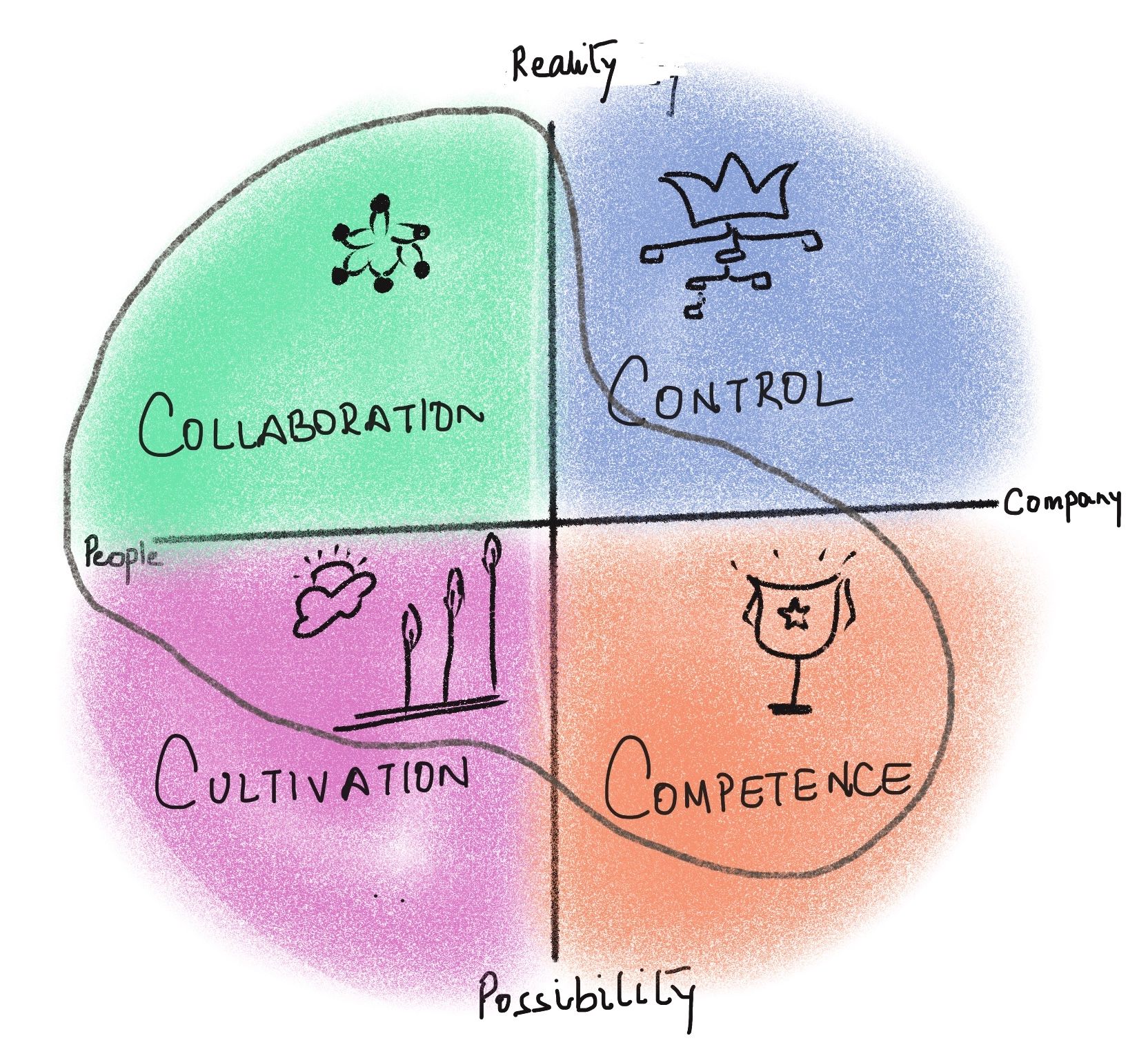A map of ThoughtWorks Culture
Our lived experience of the current ThoughtWorks culture through the lens of Schneider's Core Culture Model.

In our work to strengthen the culture of cultivation at ThoughtWorks, specifically ThoughtWorks India, we’ve often used the Schneider model to illustrate the type of culture we currently have and how it has evolved over time. It is of course impossible to paint a finely detailed & nuanced picture of our culture in a brief article, but think of this as broad brush strokes on the canvas if you will. We will look at each quadrant of the Schneider model and map the ThoughtWorks culture against it.
Prefer listening? Tune into this article on our podcast. Subscribe for more.

ThoughtWorks has been a pioneer in the Agile movement & a champion of applying Extreme Programming. So it’s no surprise that the culture of collaboration has been our most dominant culture for a long time. Agile / XP as a philosophy & practice assumes collaboration as an underlying principle.
If you walk into any ThoughtWorks office and observe the space and people even briefly, you will see collaboration woven into every thread of our fabric.
Large open team tables, several open community spaces, brainstorming boards filled with ideas, group painting/art walls & numerous such artefacts. Most importantly, you will see people banded together, in groups both large and small, talking passionately or engaged in some activity. If you spend an entire day at a ThoughtWorks office, it would be difficult for you to find 5 straight minutes when there isn’t a group activity or group conversation going on about something!
Within teams people come together in pairs or groups to deliver to clients, and beyond teams they come together in communities to learn & share. If you asked people questions about policies & procedures regarding something, you will likely be met with blank stares or embarrassed giggles. But a second or two later you will see a string of people asking around about it, someone will shout out the answer and viola! Problem solved!
That’s how most things get done - through and with people. People rely on each other for everything & figure things out together as they go.
Walk into a meeting, and you won’t know who the team lead is. Everyone will be sharing their opinion. Decisions will likely get made collectively by the group. When big changes are occurring, leadership will rely on key influencers to spread the word and bring alignment within their spheres of influence.
Being part of a larger group is a key part of a ThoughtWorker’s identity and we hold the collective above the individual.
The culture of competence is also easily noticeable at ThoughtWorks. Although some of its more individualistic aspects aren’t as common, many elements are foundational to us as a company. ThoughtWorkers immensely value their craft and amongst our most enduring heroes & heroines are those who are seen as masters of their craft. Rebecca Parsons & Martin Fowler are the most visible examples. “Pursuit of Excellence” is one of our core values as a collective. We take pride in constantly pushing the boundaries and getting better at what we do. Much of the XP construct is deeply resonant with a competence culture, and that explains our eternal love affair with XP as well! We are known as innovators and disruptors in the industry, and that comes from an insatiable hunger to keep learning & raising the bar for ourselves.
We are relentless about refining our craft & we never get too comfortable with our success. Our pride as ThoughtWorkers is anchored in the culture of competence that we have nurtured since our inception.
The culture of cultivation has been alive at ThoughtWorks, perhaps since the very beginning. When Roy Singham founded ThoughtWorks, he was looking to create something far more impactful & meaningful than an extractive corporate machine. It’s not an exaggeration to say then, that we’ve always carried seeds of a cultivation culture in our DNA.
A larger purpose of using our skills & resources in service of creating a better world, has remained essential to our being since we took birth as an organisation. It may not always be obvious, almost never loud, but always present in the subtext of our story.
As a collective, we have an immense capacity to put others over self. Indefatigable activists, dedicated mentors, transformative coaches & skilful facilitators - you are bound to encounter these archetypes whenever you meet a group of ThoughtWorkers. Both within & outside teams, there is an abundance of knowledge & experience sharing rituals. Teams have their own creative feedback rituals to help each other grow continuously. There are myriad inspiring stories of how people have gone out of their way to nurture & coach others. Personally, this is the aspect of ThoughtWorks culture that we cherish the most.
Not surprisingly, ThoughtWorkers have a psychological distance from the world of structure & order, especially the well defined boundaries and rules it contains. So the culture of control is quite weak at ThoughtWorks. Procedures, titles and positional authority have historically held little value here. Of course, any organisation does need some guidelines & processes to be followed and so do we. As we have grown in size, the necessity for having stronger controls in some areas of our business has increased as well. We’ve stepped up to this need and kept evolving our functions & processes to ensure we serve our business needs well. There are also certain functions that by their very nature have more elements of this culture. An example is our finance teams globally, that create & follow well defined guidelines to run the finances of the company smoothly. But it remains an exception rather than a rule.
It’s hard to imagine that a culture of control will ever become a pursuit at ThoughtWorks since it stands at odds with our most foundational values.
A few years ago, we began to talk about the value of strengthening our cultivation culture globally. In a nutshell, we are quite convinced that we need ThoughtWorks to embody this culture more widely & deeply in the coming years. We’ll talk about the why behind this thinking in a separate article.
At ThoughtWorks India, while efforts were gradually being made in this direction, we decided to make a dedicated investment in the Cultivation Program in 2018. The program has continued to evolve over time. We will write about the program philosophy, framework, tools & lessons learned in other articles here. It’s been an interesting journey to say the least and we are keen to keep sharing what we learn with you. So keep reading on!
References:Roy’s Social Experiment - Martin Fowler’s blog
Cover image credit: Jr Korpa on Unsplash
Schneider model illustration: by Our Culture Cafe




